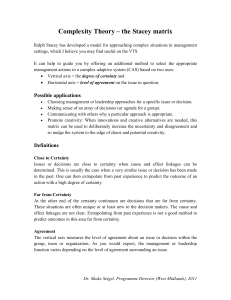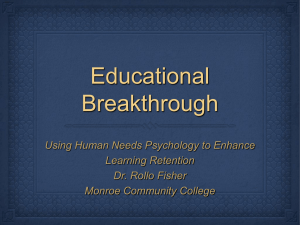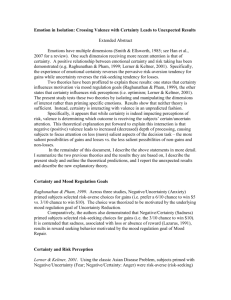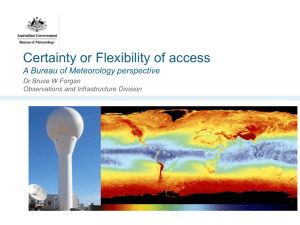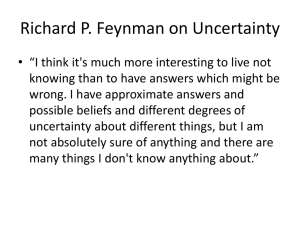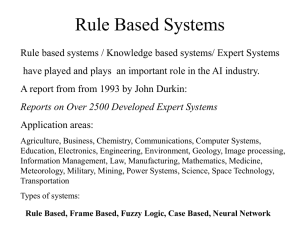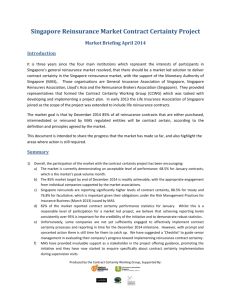Uncertain knowledge
advertisement
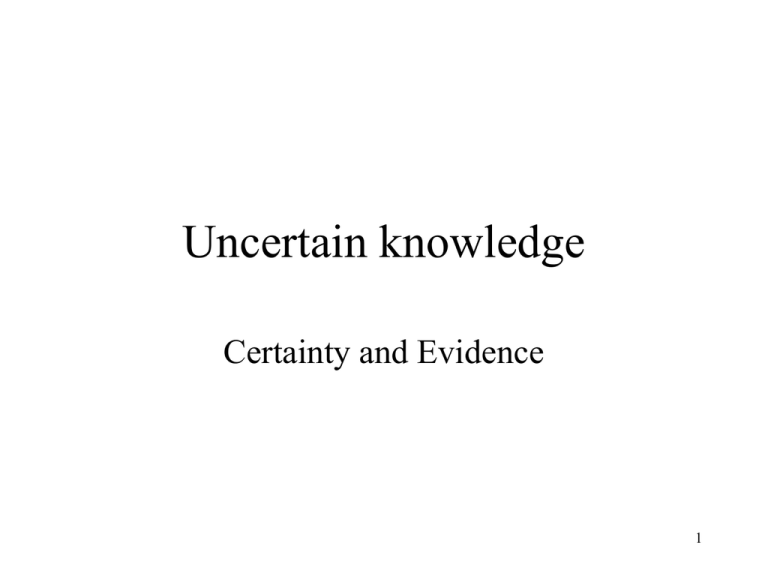
Uncertain knowledge
Certainty and Evidence
1
Structure of a rule-based expert system
External
Database
External Program
Expert System
Knowledge Base
Database
Rule: IF-THEN
Fact
Inference Engine
Explanation Facilities
User Interface
User
Developer
Interface
Knowledge Engineer
Expert
2
Example Rule
Legal knowledge
Rule
if
and
and
and
and
and
then
the plaintiff did receive an eye injury
there was just one eye that was injured
the treatment for the eye did require surgery
the recovery from the injury was almost complete
the visual acuity was slightly decreased by the injury
the condition is fixed
increase the injury trauma factor by $10000
Rule
if
and
the plaintiff did not wear glasses before the injury
the plaintiff's injury does require the plaintiff to
wear glasses
increase the inconvemience factor by $1500 3
then
Problems with Knowledge
Knowledge is usually incomplete, inconsistent,
uncertain, or all three.
4
Uncertainty
Uncertainty is defined as the lack of the
exact knowledge that would enable us to
reach a perfectly reliable conclusion.
Classical logic permits only exact
reasoning. It assumes that perfect
knowledge always exists and the law of the
excluded middle can always be applied. ~T
=F
5
Sources of uncertain knowledge
Weak implications. Domain experts and
knowledge engineers have the painful task of
establishing concrete correlations between IF
(condition) and THEN (action) parts of the rules.
Therefore, expert systems need to have the ability
to handle vague associations, for example by
accepting the degree of correlations as numerical
certainty factors.
6
Uncertainty in Terminology
Terminology: Medical (and other life and human sciences)
terminology allows considerable scope for vagueness, ambiguity,
inexactness,imprecision and/or uncertainty:
• "adequate" dosage of a drug
• "stable" condition of patient
• 'the patient is "feverish"'
• 'this is a "possible" case of meningitis
7
Exercise
Due to linguistic imprecision it can be difficult to express
knowledge in the precise IF-THEN form of production rules.
Sortthe following terms in a column in order of certainty from most
certain to least certain.
usually, seldom, hardly ever, rarely, often, always, may be,
generally, normally, usually not, certainly, not often, now and then,
rather often, generally, never, frequently, very often, not always,
about as often as not, sometimes, infrequently, once in a while,
almost never, commonly, by-and-large, hardly ever
Next to each write a number between 0 and 100 representing the
certainty that you associate with terms such as usually, often,
8
sometimes, generally . . .
Unknown data
When the data is incomplete or missing, the only
solution is to accept the value “unknown” and
proceed to an approximate reasoning with this value.
9
Views of different experts.
Large expert systems usually combine the
knowledge and expertise of a number of
experts. Unfortunately, experts often have
contradictory opinions and produce
conflicting rules. To resolve the conflict, the
knowledge engineer has to attach a weight to
each expert and then calculate the composite
conclusion. But no systematic method exists
to obtain these weights.
10
Certainty Factors
Consider a simple rule:
IF
A is X
THEN B is Y
An expert may not be absolutely certain that this rule
holds.
IF
A is X
THEN B is Y {cf 0.7};
11
Class Exercise - Construct a rule base representing this knowledge
A doctor explains the following to a knowledge engineer: “Nasal congestion
together with a sore throat generally indicates a strep throat. A strep throat and
chest congestion together usually indicate allergic rhinitis. Chest congestion,
nasal congestion and a sore throat together are often an indication of pneumonia.
Chest congestion and nasal congestion without the sore throat can also indicate
pneumonia.”
12
Certainty Factors Calculations
The certainty factor assigned by a rule is propagated
through the reasoning chain. This involves
establishing the net certainty of the rule consequent
when the evidence in the rule antecedent is uncertain:
cf (H,E) = cf (E) cf
13
Example,
IF
sky is clear
THEN the forecast is sunny {cf 0.8}
and the current certainty factor of sky is clear is 0.5, then
cf (H,E) = 0.5 0.8 = 0.4
This result can be interpreted as “It may be sunny”.
14
Certainty of Conjunction
evidence
.. E1
.
AND evidence En
THEN hypothesis H {cf }
IF
the certainty of hypothesis H, is established as follows:
cf (H,E1E2...En) = min [cf (E1), cf (E2),..., cf (En)] cf
15
Certainty of Conjunction
For example,
IF
sky is clear
AND the forecast is sunny
THEN the action is ‘wear sunglasses’ {cf 0.8}
and the certainty of sky is clear is 0.9 and the certainty of the
forecast of sunny is 0.7, then
cf (H,E1E2) = min [0.9, 0.7] 0.8 = 0.7 0.8 = 0.56
16
Certainty of Disjunction
evidence
.. E1
.
OR
evidence En
THEN hypothesis H {cf }
IF
the certainty of hypothesis H, is established as follows:
cf (H,E1E2...En) = max [cf (E1), cf (E2),..., cf (En)] cf
17
Example
IF
sky is overcast
OR
the forecast is rain
THEN the action is ‘take an umbrella’ {cf 0.9}
and the certainty of sky is overcast is 0.6 and the certainty of the
forecast of rain is 0.8, then
cf (H,E1E2) = max [0.6, 0.8] 0.9 = 0.8 0.9 = 0.72
18
Alternately - Two pieces of evidence
Suppose the knowledge base consists of the following
rules:
Rule 1: IF
A is X
THEN C is Z {cf 0.8}
Rule 2:
IF
B is Y
THEN C is Z {cf 0.6}
What certainty should be assigned to object C
having value Z if both Rule 1 and Rule 2 are used?
19
Accumulation of Evidence
Common sense suggests that, if we have two
pieces of evidence (A is X and B is Y) from
different sources (Rule 1 and Rule 2) supporting
the same hypothesis (C is Z), then the confidence
in this hypothesis should increase and become
stronger than if only one piece of evidence had
been obtained.
20
Accumulation of Evidence Calculation
cf1 + cf2 -(cf1 * cf2)
where
cf1 is the confidence in hypothesis H established by Rule 1;
cf2 is the confidence in hypothesis H established by Rule 2;
1 > cf1 + cf2 -(cf1 * cf2) > max(cf1,cf2)
21
Exercise - Calculation of Certainty
in a derivation tree
Draw the derivation tree and calculate the certainty of G
A & B -> G (90)
C | D -> A (80)
E -> B (90)
F -> B (80)
C (70)
D (90)
E (80)
F (80)
22
Thresholds
• As the line of reasoning proceeds the
accumulated confidence may decrease
• At a certain point we may lose confidence
in the line of reasoning
• Thresholds are used cause the inference
engine to abandon a portion of a search tree
and search for a better alternative
23
The certainty factors theory provides a practical
alternative to Bayesian reasoning. The heuristic
manner of combining certainty factors is different
from the manner in which they would be combined
if they were probabilities. The certainty theory is
not “mathematically pure” but does mimic the
thinking process of a human expert.
24
